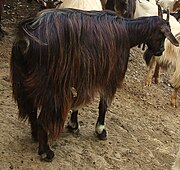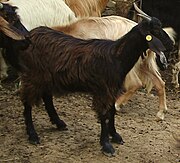
The Bionda dell'Adamello is an indigenous breed of domestic goat from the Val Camonica in the province of Brescia, in Lombardy in northern Italy. It takes its name from the massif of the Adamello, part of the Adamello-Presanella subsection of the Rhaetian Alps. It is raised mainly in the Val Camonica, the Val Saviore and the mountains of Brescia; some are found in neighbouring areas of the provinces of Bergamo to the west and Trento to the east. It was in the past known simply as the Capra Bionda or as the Mustàscia.
The Maltese is a breed of domestic goat from the east and central Mediterranean area. It originates in Asia Minor, and takes its name from the island of Malta. It is raised mainly in southern Italy, and particularly in the islands of Sicily and Sardinia. Although the Maltese: Mogħża Maltija is reported to DAD-IS, the official view is that there are no pure-bred specimens of the breed in the Maltese islands, although it is possible that some modern Maltese goats are closely related to the original type. The Maltese is also present in Greece, Turkey and the Maghreb.
The Sarda is an indigenous breed of domestic goat from the Mediterranean island of Sardinia, off the west coast of central Italy. It is raised throughout the island, particularly in the provinces of Cagliari and Nuoro. It is an ancient breed that has been influenced by the Maltese goat.
The Rossa Mediterranea is a breed of domestic goat from the Mediterranean island of Sicily, in southern Italy. It derives from the Damascus goat of Syria and the eastern Mediterranean, and is thus also known as the Derivata di Siria. It is raised mainly in Sicily, but also in Basilicata and Calabria in southern mainland Italy.
The Passeirer Gebirgsziege or Capra Passiria is an indigenous breed of domestic goat from the Passeier valley or Val Passiria, in the Autonomous Province of Bolzano in north-eastern Italy. It is raised in that valley and in the neighbouring Sarntal, Schnalstal and upper Wipptal valleys; it is also present in neighbouring areas of southern Austria. While of Alpine type, it is morphologically quite distinct from the Alpina Comune goat breed. Management is extensive: the animals are kept on alpine pasture from early spring to late autumn.
The Napoletana is a breed of domestic goat from the area south of Naples, in Campania in southern Italy. It is raised on the slopes of Vesuvius, on the slopes of the Monti Lattari, and in the Agro Nocerino Sarnese which lies between them. The origin of the breed is unknown. It may derive from goats of African origin imported to the area in the early years of the twentieth century; the alternative name Torca Nera, "black Turkish goat", suggests an origin in the Mediterranean basin.
The Grigia Molisana is an indigenous breed of greyish domestic goat from Molise in southern Italy. It is raised in the comuni of Acquaviva Collecroci, Castelmauro, Montefalcone nel Sannio, Montemitro and San Felice del Molise; all are in the province of Campobasso, and the breed may also be called the Capra di Campobasso. The highest concentration is in Montefalcone, from which the name Capra di Montefalcone derives. The origins of the breed are not known; studies conducted in the 1980s suggest influence from the Alpino Comune, Garganica and Maltese breeds.
The Di Teramo is an indigenous breed of domestic goat from the province of Teramo, in Abruzzo in southern Italy, and is raised only in that area. Numbers are very low; the breed was listed as endangered by the FAO in 2007. It is further threatened by cross-breeding with the Garganica breed.
The Rustica di Calabria or Sciara is an indigenous breed of domestic goat from Calabria in southern Italy. It is raised mostly in the provinces of Catanzaro and Cosenza. Although present in substantial numbers it has been little studied; its conservation status and origins remain unclear. It may have been influenced by the various goat breeds, including the Abyssinian goat, the Maltese and a type known as "Tibetan", whose introduction to Calabria in the early twentieth century is documented.
The Cilentana Nera is an indigenous breed of domestic goat from the province of Salerno, in Campania in southern Italy. It takes its name from the geographical region of the Cilento, much of which is today within the Parco Nazionale del Cilento, Vallo di Diano e Alburni, and is raised mainly in that area and in the Monti Alburni. The range extends to the Monti Picentini and to the area of Ricigliano in eastern Campania and Muro Lucano in Basilicata. It is one of three goat breeds in the Cilento, the others being the Cilentana Grigia and the Cilentana Fulva. The Cilentana Nera is found on higher ground and poorer pasture than the other two, and is raised mainly for meat. It has been influenced by the Garganica and Napoletana goat breeds.
The Cilentana Fulva is an indigenous breed of domestic goat from the province of Salerno, in Campania in southern Italy. It takes its name from the geographical region of the Cilento, much of which is today within the Parco Nazionale del Cilento, Vallo di Diano e Alburni, and is raised in that area, in the Monti Picentini, and throughout the province of Salerno. It is one of three indigenous goat breeds in the Cilento, the others being the Cilentana Grigia and the Cilentana Nera. The Cilentana Fulva is found on lower ground and richer pasture than the Cilentana Nera, and is raised mainly for milk. It appears to derive from inter-breeding of local goats with the Maltese and particularly the Derivata di Siria, with which it shares many characteristics.
The Cilentana Grigia is an indigenous breed of domestic goat from the province of Salerno, in Campania in southern Italy. It takes its name from the geographical region of the Cilento, much of which is today within the Parco Nazionale del Cilento, Vallo di Diano e Alburni, and is raised mainly in that area, but also in the Monti Alburni and the Monti Picentini. It is one of three indigenous goat breeds in the Cilento, the others being the Cilentana Fulva and the Cilentana Nera. The Cilentana Grigia is found on lower ground and richer pasture than the Cilentana Nera, and is raised mainly for milk. The origins of the breed are obscure; it shows the influence of the Maltese and Garganica breeds, and similarities to other Italian grey breeds such as the Ciociara Grigia of Lazio and the Argentata dell'Etna from Sicily.
The Argentata dell'Etna is an indigenous breed of domestic goat from the area of Mount Etna in the province of Catania and the Monti Peloritani in the province of Messina, in the Mediterranean island of Sicily, in southern Italy. It is raised mainly in that area, but also in the provinces of Enna and Palermo. It is named for the volcano and for its silvery grey coat. The origins of the breed are unknown; it shows similarities to the Garganica breed, and to other Italian grey breeds such as the Ciociara Grigia of Lazio and the Cilentana Grigia of Campania.
The Nicastrese is an indigenous breed of domestic goat from Calabria, in southern Italy. It originates in the province of Catanzaro, and takes its name from the former town of Nicastro, which since 1968 has been part of Lamezia Terme. The Nicastrese is raised mainly in the area of origin, but also in the neighbouring provinces of Cosenza and Reggio Calabria. Photographic evidence suggests that it may be closely connected to the old "Araba" breed of the area.

The Nera Verzasca, also known as the Nera di Verzasca or Verzaschese, is an indigenous breed of black domestic goat from the Valle Verzasca, in the canton of Ticino in southern Switzerland, from which it takes its name. It is raised in that area and in the provinces of Como, Varese and Verbano Cusio Ossola in northern Lombardy, in the north of Italy.
The Valfortorina or Capra di Benevento is a rare breed of domestic goat from the Val Fortore in the province of Benevento, in Campania in southern Italy. It survives in very low numbers, and its conservation status was listed as "critical" by the FAO in 2007. A small number are kept at Benevento by the Consorzio per la Sperimentazione, Divulgazione e Applicazione di Biotecniche Innovative (ConsDABI), the institution responsible for the conservation of genetic resources in Italy.
The Roccaverano is an indigenous breed of large domestic goat from the Langhe, in the provinces of Asti and Cuneo, in Piemonte in north-western Italy. It is raised mainly in the Langa Astigiana, mostly within the Comunità montana Langa Astigiana Val Bormida, and is named for the town and comune of Roccaverano in that area. The origins of the breed are unknown.

The Chamois Coloured Goat, French: Chèvre chamoisée, German: Gämsfarbige Gebirgsziege, Italian: Camosciata delle Alpi, is an indigenous breed of domestic goat from Switzerland. It is distributed throughout Switzerland and in parts of northern Italy and Austria, and has been exported to other countries including France. There are two strains, a horned type from the Grisons or Graubünden in the eastern part of the country, and a hornless type from the former bezirk of Oberhasli and the area of Brienz and Lake Brienz in the Bernese Oberland in central Switzerland. In some countries the hornless variety may be considered a separate breed, the Oberhasli goat. The Swiss herd-book was established in 1930.

The Frisa Valtellinese is an indigenous breed of domestic goat from the province of Sondrio, in Lombardy in northern Italy. It is raised throughout the Valtellina, from which its principal name derives, in the Val Malenco and the upper Val Masino in the Rhaetian Alps, and in the Valchiavenna. It may also be called the Frontalasca, for the village of Frontale, a frazione of the comune of Sondalo in the Val di Rezzalo, or the Rezzalasca for that valley. The name Frisa comes from its frisature, or Swiss markings.
The Di L'Aquila or Capra di L'Aquila is an indigenous breed of domestic goat from the province of L'Aquila, in Abruzzo in southern Italy. It is raised only in that province. It is a heterogeneous breed with variable characteristics, showing the influence of introductions of Alpina Comune, Girgentana, Maltese and Toggenburg stock. It is large, hardy and productive. Management is extensive: the animals are kept on mountain pasture, and brought under cover for protection from the snow only in the winter months.







